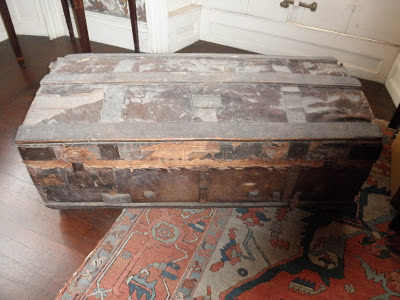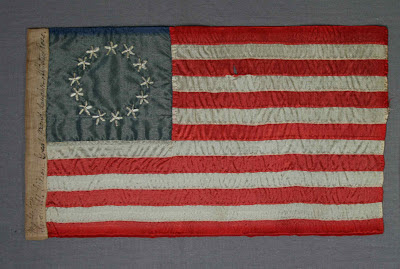At the end of the day, does your collection of swabs look like this?
Much of the work that conservators perform on collections is removing surface dirt. Either mechanically with swabs, picks, or brushes; or capturing with vacuums. Much of this dirt has been accumulating while the artifact has been at the museum (often called "museum dirt") and is not the dirt that is associated with use or historical significance.
Summer begins today and with it comes a very busy time at historic homes and museums. Smaller institutions with a limited open season see all of their visitors in this short time before they close down again for the cold months of winter. So what kind of effect does this quick and short influx of visitors have on these places? The answer is that the extra traffic can have a profound impact, but if great care is taken to monitor for dust and dirt, then that impact can be made minimal. This is true not just for the small institution, but for the large institution as well where visitors are seen year-round.
 |
| This chest is covered in animal hair, but along with it, is dust, (lots of it) and closer inspection reveals insect and water damage. Prevention could have made a substantial difference here. |
Common dust components can be anything from soil, soot or insects (that perhaps you would expect to find), to the hair and skin particles from humans or animals, to the paint or plaster from a home, or could be things like particles of paper, food, fiber, or heaven forbid - mold. Dust is bad enough by itself, and this is nothing new as Susannah Whatman, in her iconic housekeeping book of 1776, so aptly indicated when she said, "Places where dust lodges should be attended to. Otherwise, if left too long, it takes a long time and much labor to get it off". Is there something worse than leaving dust undisturbed for too long? Yes, and it is a simple and deadly equation: Dust + Humidity = "dirt cement" = hard or damaging to remove. This is why a favorite saying in conservation is: "Prevention is better than cure".
Sticky samples to the rescue! Simple prevention does not get simpler than this. Sticky samples collect and show the evidence of what is in the environment. Most importantly they indicate how often an area needs to be cleaned. It should be of no great surprise that when the samples below were examined, the samples farthest from the visitor "rope" showed less dust pollutants. The moral of the story here is to put the objects you want to clean less, farther away from the traffic flow. Another interesting tidbit is that the samples at the beginning of the tour have much more dust than the sticky samples at the end of the tour. Of even further interest is that the sticky samples on the floor have far more dust collected than the samples on a table or up even higher. In fact 4 feet from the ground is the magic number. Here is the least "dusty" space. However, move up above the average person's eye-level and things start getting dusty again. This makes sense - when was the last time you looked at the top of your refrigerator?
 |
| The white squares indicate where tested, at regular intervals from the path of a visitor (the red rope is the limit of the visitors contact) |
Is seems that there is a fine line between a historic institution having the right amount of dust (i.e. what is acceptable to the visitor vs. what comes off as making the institution look "uncared" for.) As conservators, curators, and archivists, we have all studied patterns of dirt and soiling migrations within environments. And as one might suspect, it is mainly the visitors themselves who bring the dirt and soiling into museums and historic homes. Folks like Mr. Peter Brimblecombe of the University of East Anglia, UK and others who have studied and monitored such things are able to provide us with the knowledge of how the movement and deposition of dirt and particulates damages historic homes, museums, archives and libraries.
But could there be a time when this is not the case? And a conservator's first step of treatment will not be surface cleaning or vacuuming?
Homes, work space, and other public spaces are all becoming more and more clean. Modern building construction is tighter to be more energy efficient. Windows are not made to open in some buildings because a HVAC system is in place, and these systems are equipped with sophisticated filters, able to wisk the air clean of particles and debris to the micron level. Society itself has become more concerned than ever before with hygiene. There are biological antiseptic hand wipes, washes, and cleaners, all to keep our environments clean and germ free. Plus there are improved vacuum cleaners with fine particulate filters like HEPA and speed regulation.
How is this going to effect a conservator's work in the future? Could it be that vacuuming as a first step not be needed? What do you think?
Notes: Housekeeping is one of my favorite topics and more will come, but it is impossible to talk about dust in its entirety in a brief blog post. If you want to read some wonderful articles, please visit Professor Peter Brimblecombe's web page where you will find links to his mountains of publications about dust, historical places and the environmental factors that can cause damage. He may be more passionate about housekeeping than I am!
_____________________________Gwen Spicer is a textile conservator in private practice. Spicer Art Conservation specializes in textile conservation, object conservation, and the conservation of works on paper. Gwen's innovative treatment and mounting of flags and textiles is unrivaled. To contact her, please visit her website.










